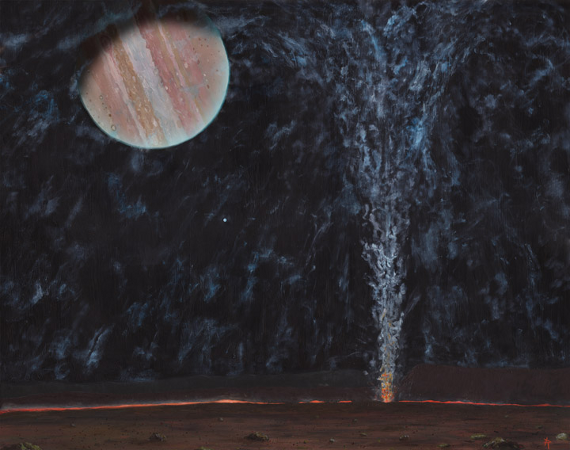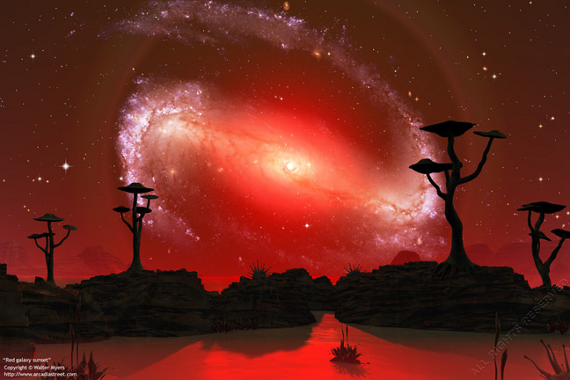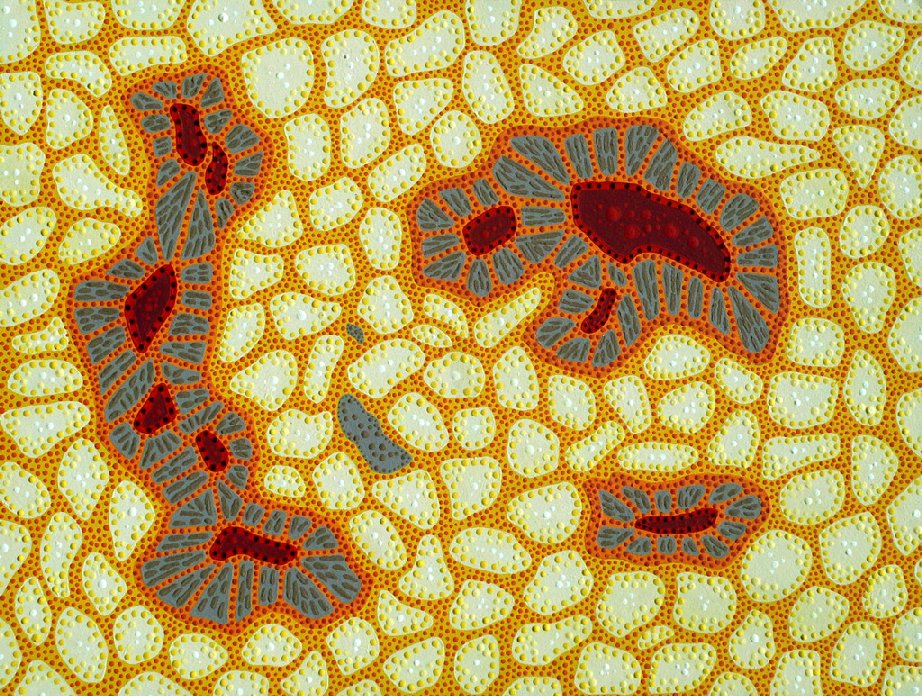
Chances are if you are the kind of person who looks up into the night sky and stops in wonder, you are also the kind of person who would climb aboard a starship and go see those distant wonders up close if offered a seat. Don’t worry, you are not alone in those “otherworldly” desires! Unfortunately, we don’t have starships (yet!), but we do have the next best thing – human imagination. And if you combine that imagination with those otherworldly desires and some artistic talent, you get a group of people who actually do go “out there” every day, the International Association of Astronomical Artists (IAAA for short).
“Space” or “astronomical” art is the embodiment of that extraterrestrial leap in human imagination. It is a genre of artistic expression that strives to show the wonders of the Universe, despite the artist having never been to the place they are depicting. Inspiring, uplifting, even mesmerizing, space art helps to fulfill a deep set need in the human spirit to go and see. We are a species of explorers; it is in our very nature to wonder about what is over the next hill, across the river, beyond that mountain, on the next planet. And when we can’t go there ourselves, we send the imagination of an artist.

The IAAA is the only guild of artists in the world dedicated to bringing those distant wonders down to Earth all to marvel at. Founded in 1982, the IAAA today has nearly 120 members across the world, all working to expand the boundaries of the human mind. You have probably seen the work of an IAAA member without even knowing it. From book and magazine covers to movie effects to artistic images illustrating the newest astronomical discoveries, the IAAA is the vanguard of artistic space exploration.
Space art as a genre isn’t new. Artworks depicting space, the objects in it, and the world viewed from it have been made by artists for literally thousands of years. Egyptians painted constellations on the ceilings of their royal tombs and made comprehensive circular zodiac maps of the constellations; ancient Greeks knew that the Earth was round from observing lunar eclipses and drew their maps accordingly; Mayan artwork is as filled with astronomical representations as their detailed calendar system was; Italian Renaissance artist Giotto di Bondone added a comet to a painting in 1301; German artist Albrecht Durer created the first known drawing of Earth as a globe in 1515. As technology and knowledge expanded the human mind, the viewpoints of artists also expanded.
Hans Lippershay’s invention of the telescope in 1608 was quickly improved upon by Galileo and soon led to incredible discoveries of valleys and mountains on the Moon, phases of other planets, and the moons of Jupiter. Artists found these discoveries just as inspiring. In 1711 Italian artist Donato Creti painted the first known close up views of other planets as seen through a telescope for a commission for the Vatican. As the pace of human learning increased, so too did the artistic representation of the world around us. When events like comets, meteor showers, and spectacular fireballs happened in the sky above, artists quickly painted and drew what they saw. After the invention of moveable type in the 1440s, books quickly began displaying art and drawings too, including astronomical art.

Writers began placing stories in outer space, such as Jules Vernes’ “From the Earth to The Moon” in 1865 and “Off on a Comet” in 1877. Interestingly, “Off on a Comet” has an illustration by Paul Dominique Phillipoteaux showing a view of Saturn’s rings from below, from the planet itself. This may have been the first work of art showing the view from the surface of another planet besides Earth, the first piece of modern astronomical art. Other books with astronomical illustrations began coming out at an ever increasing pace, books like “Worlds in the Sky” by Camille Flammarion, and “On Other Worlds” and “How to Study the Stars” by the artist considered to be the grandfather of astronomical art, Lucien Rudaux.
Rudaux painted hundreds of astronomical works, many of which are still scientifically accurate depictions today. His work in turn inspired Ludek Pesek and the great Chesley Bonestell, the “father” of astronomical art. Pesek and Bonestell both illustrated numerous books and magazine articles and Bonestell’s seminal 1952-54 series in Colliers Magazine, “Man Will Conquer Space Soon!” is considered by most to be the inspiration behind America’s space program. Indeed, Bonestell’s work “Titan From Saturn” is the reason many artist members of the IAAA actually began painting space art in the first place and is often called “the image that launched a thousand careers.”

The combination of scientific discovery and public realization that there was a vast universe surrounding us lead to an explosion of curiosity and creation in the early 20th century. Astronomical art became a permanent part of the public imagination, though there were still few who painted it. Today, the public psyche is firmly rooted in space. The most popular entertainment franchises of all time include Avatar, Star Wars, Star Trek, Battlestar Galactica, and many more stories set in outer space. Current space art production is not limited to just entertainment though, humanity’s greatest achievements all involve space, landing a man on the Moon, discovering planets outside our solar system, landing rovers on Mars, sending probes to Jupiter and Saturn, even landing a probe on Bonestell’s beloved Titan, and every single one of those achievements was foreseen by an artist. Space artists’ works are used to illustrate the latest scientific discoveries, giving views of things that we cannot yet send a camera to picture, things like a view of Jupiter’s cloud decks, Saturn’s rings from below, volcanic eruptions on Io, or places so far away that we may never be able to send a camera, like inside a globular cluster or the surface of a living planet in a distant galaxy.

Like other artistic expressions, space art has many facets. It isn’t just about painting scientifically accurate images, though may IAAA artists strive to do just that. Space art is also about inspiring people, making them think and feel, raising their emotions, raising a sense of awe in them. The genre of space art encompasses realism, impressionism, hardware art, sculpture, abstract imagery, even zoological art. Though artists have been making art with astronomical elements for a long time, the genre of Space Art itself is in its infancy, having begun only when humanity gained the ability to look off our world and artistically depicted what we see out there. And like other genres of artistic endeavors in their infancy, even the definition of the term “Space Art” is still in flux. Basically though it is any artistic endeavor that has “space” as a subject matter. And also like other artistic genres, a viewer knows what it is when they look at it. No matter the exact definition of the different aspects of Space Art though, members of the IAAA create them all.
Our home planet is only one small globe amongst trillions and trillions of other planets in the universe. In order to create better imagery of those trillions and trillions of other places, IAAA artists study the one place they can travel to and around, Earth. There are analogs of Mars and Venus here on Earth, places where our planet looks like Calisto or Io. We go to those places to study the environment and inspire us to create more accurate and believable locations to send our imaginations to. By combining scientific principles with plausible settings and artistic imagination, IAAA artists create images of the things humanity will someday encounter “out there.” The physical laws of the Universe are the same everywhere. Gravity pulls, chemicals react, light reflects. The interaction between rock, atmosphere, and light is the same no matter where in the galaxy the rock and atmosphere are. We in the IAAA are delighted to show you just how “Amazing” our universe is.
Jon Ramer
President, IAAA

A few additional images from the President of the Visualized Galaxy, Joe Ramer:

Copyright © Joe Ramer. All Rights Reserved.

© Copyright Joe Ramer. All Rights Reserved.

Copyright © Joe Ramer. All Rights Reserved.

Copyright © Joe Ramer. All Rights Reserved.









